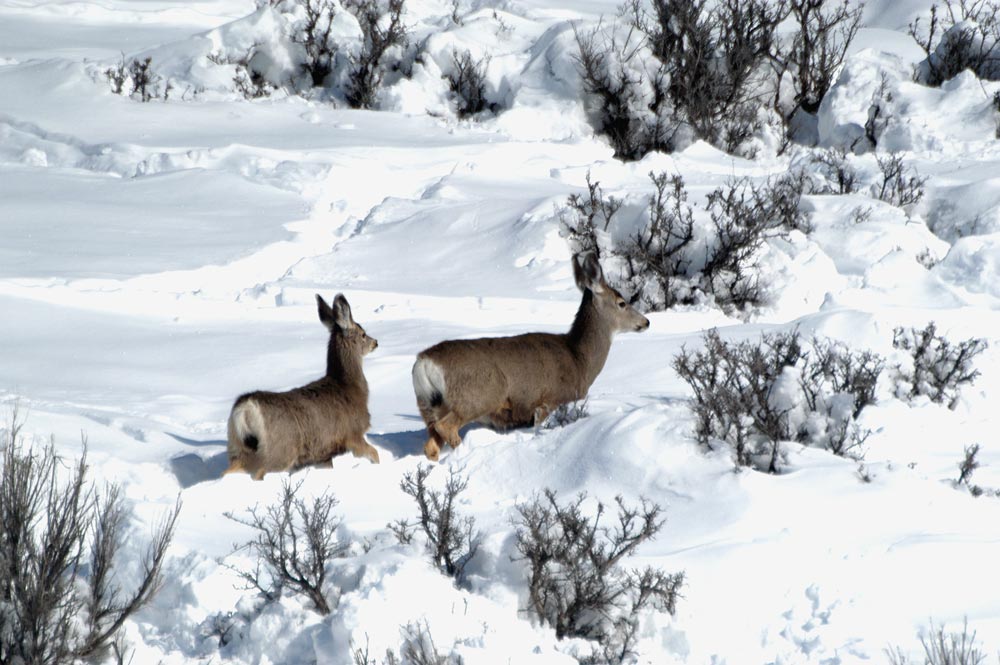Winter provides great opportunities to view Idaho wildlife, but it is very important to enjoy the view from a distance. Winter can be very stressful for wildlife, especially in winters like this when snow is deep or crusted.
“Wintering big game animals are very susceptible to any kind of disturbance whether it is from passing motorists, domestic dogs, or antler hunters in late winter and early spring,” said Daryl Meints, Fish and Game wildlife manager based in Jerome. “And there’s growing concern that winter recreationists are putting additional stress on wintering big game in many areas of the state.”

At this time of year, deer and elk are relying solely on their body reserves and what little they can get from surrounding vegetation. Any extra movement an animal makes costs energy and that depletes the reserves it has left. Energy depletion can lead to malnutrition and oftentimes death, especially for fawns and calves at this critical time of year.
“Right now, deer and elk are just trying to hang on until spring green-up,” said Meints. “Some animals may be pushed over the edge unintentionally by people, and we all need to keep that in mind.”
Besides avoiding wintering deer, elk and pronghorn as much as possible, recreationists can help big game get through the winter by following these simple steps:
Refrain from antler hunting.
While there are no seasons or rules directly
related to antler hunting in Idaho, unfortunately, many are taking to the hills to gather antlers during the
worst time of the year for the animals. Even if access is allowed into an area, please consider the potential
stress caused to wintering big game. Remember, just because you can go somewhere doesn't mean you should.
Avoid recreating near wildlife.
The same goes for those who ski, hike, or ride
snowmobiles in areas with big game.
Human presence alone is enough to cause animals to move and act differently than they would have without that
disturbance. A single instance of human disturbance may not be that disruptive, but consider several days
of human activity and disturbance to animals already stressed by winter. The energy used by animals reacting to
repeated disturbances becomes significant over time.
Several areas are closed
temporarily to human activity during winter and early spring to
provide areas free of disturbance. In eastern Idaho, these areas include lands along the South Fork of the Snake
River near Heise, the Egin-Hamer closure of the St. Anthony desert, Rainy and Fall Creek areas in Swan Valley,
and areas along the west side of the Teton Valley. Fish and Game has also temporarily closed several
wildlife management areas (WMAs) in southern Idaho including the Boise River, Tex Creek, Georgetown Summit,
Portneuf, and Montpelier WMAs to protect wintering big game.
- The public is also urged to
avoid other public lands important to wintering big game
that are open to people, but closed to motorized use. In southeast Idaho, the Blackrock area south of
Pocatello, Soda Hills near Soda Springs, and East Bear Lake Plateau near Montpelier are crucial for wintering
big game, but are not closed to human access by foot or horse. However, avoiding these areas until late
spring may help make a difference in long-term health of the herds.
For questions
about travel management plans or areas protected from human entry, contact
your local U.S. Forest Service, Bureau of Land Management, or Fish and Game regional office.
Avoid emergency winter feeding sites.
Curious visitors to emergency feeding
operations across southern Idaho have caused unnecessary disturbance to animals and a few minor interruptions to
workers. Fish and Game would appreciate the public’s cooperation in avoiding these areas.Keep dogs under your control.
Though your dog may not chase big game animals, its
presence alone may be enough to cause animals to expend unnecessary energy they would not have otherwise used.
To big game animals, a dog is a predator and the impacts of free-running dogs on wintering game can be
substantial. Fish and Game officers have investigated several incidents of dogs attacking and killing pronghorn
struggling in deep snow this winter in southeast Idaho. Remember, it is illegal to allow dogs to chase or
harass big game.Watch from a distance.
Binoculars and spotting scopes provide the ability to watch
wildlife from great distances.Use them from a distance and the animals will be better off.
